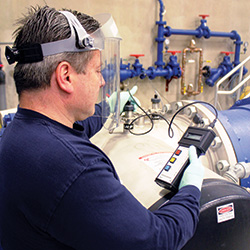
Investments in technology allow you to turn on the tap without much thought to the underlying complexities.
Throughout history, water resources have played a pivotal role. Settlements were built based on access to fresh water. From the tribal era, colonial period and industrial age to the modern day, water has been a necessary tool for domestic, industrial, agricultural and economic uses, while waterways like the Illinois River have long been transport routes for people, goods and services. Flowing water provided the power needed to process iron, timber and grain. Industrial facilities required water for heating and cooling, and a variety of chemical applications. Likewise, agricultural regions required large volumes of water for irrigation. While water has played a significant role in our community’s progress, it is also critical to present-day success.
Value of Water Service
One of the first things we do every day—sometimes before even turning on a light—is turn on the tap. We are so confident in our drinking water that we rarely double-check to make sure it is clear and safe to drink. While this is a testament to the quality of our local water service, it also speaks volumes to society’s lack of understanding of the value of safe drinking water. We simply take it for granted.
Often, the understanding of something’s true worth isn’t recognized until it is no longer readily available. So take a moment and imagine just one day without water. No showering, toilet flushing, clothes-washing or coffee-making. No washing fruits and vegetables, or boiling water to prepare a family meal. In the event of an emergency, critical fire protection would be seriously impacted. Imagine healthcare professionals trying to clean a wound or provide care without running water. In addition, the impact on local manufacturing would be significant. This exercise reminds us of the importance of reliable, safe drinking water in our community’s overall health.
Progress of Water Service
The collection, treatment, testing and delivery of safe water straight to your tap is often hailed as one of the greatest human advancements in history—specifically through chlorine disinfection. Chlorine was used for the first time as a primary disinfectant of drinking water in the early 1900s, playing a significant role in reducing the number of water-borne disease outbreaks at that time. There’s no doubt water disinfection increased overall life expectancy and ensured public health.
To help monitor drinking water quality, Congress passed the Safe Drinking Water Act in 1974. This law requires the Environmental Protection Agency (EPA) to determine water quality standards to ensure safe drinking water. Illinois American Water has a long-standing track record of meeting or surpassing those guidelines.
Over the years, the historic Main Station Water Treatment Plant serving Illinois American Water’s Peoria District for over a century has been upgraded to keep up with demand and meet these critical quality standards. Most recently, ultraviolet (UV) disinfection was installed at the 124-year-old plant to enhance water quality consistent with new, more stringent EPA standards.
The UV disinfection facility was the second of its kind in Illinois, providing another layer of protection to customers. Because of proactive investments in technology and professional staff, Illinois American Water customers can turn on the tap without giving much thought to the complex system that makes it possible. We are proud that our customers put their faith in us every day to take care of this critical service! iBi
Karla Olson Teasley is president of Illinois American Water.

